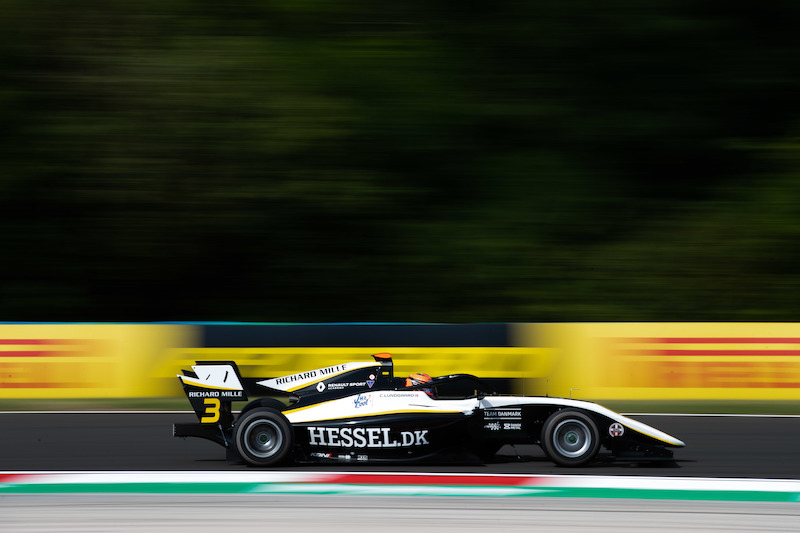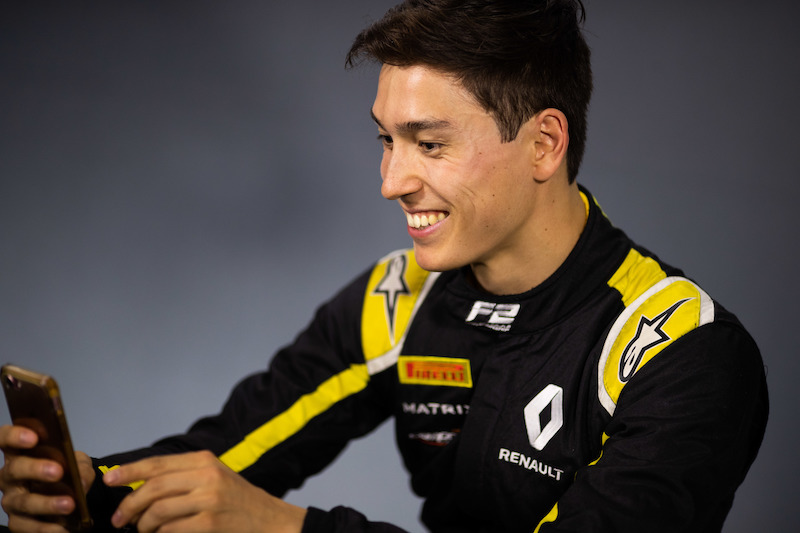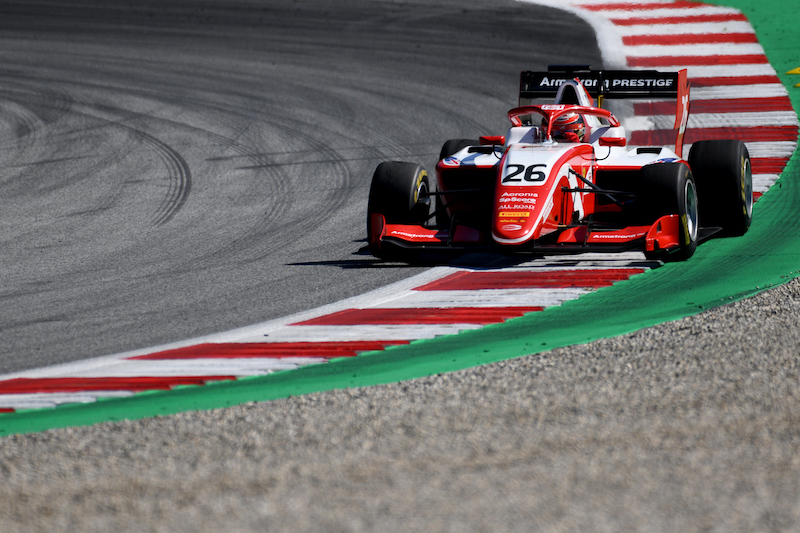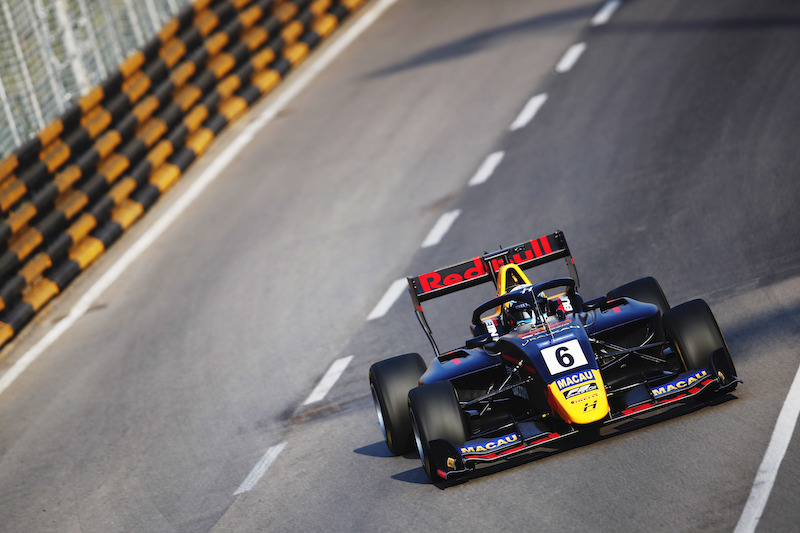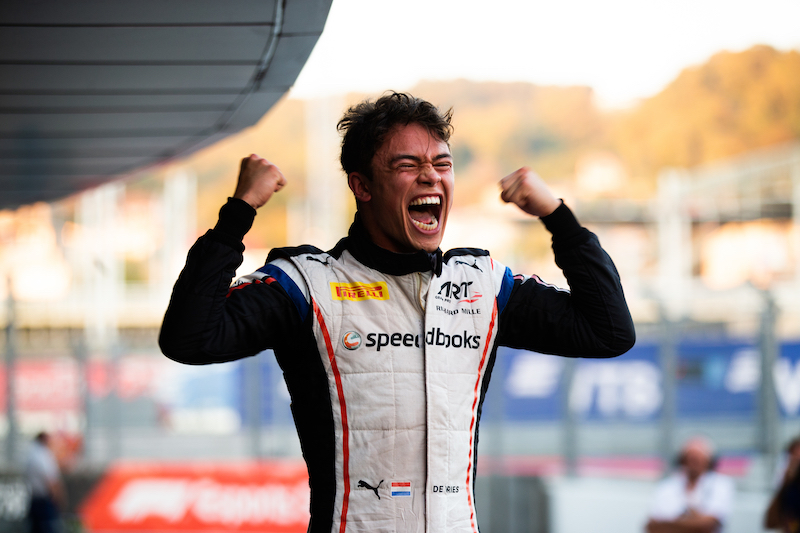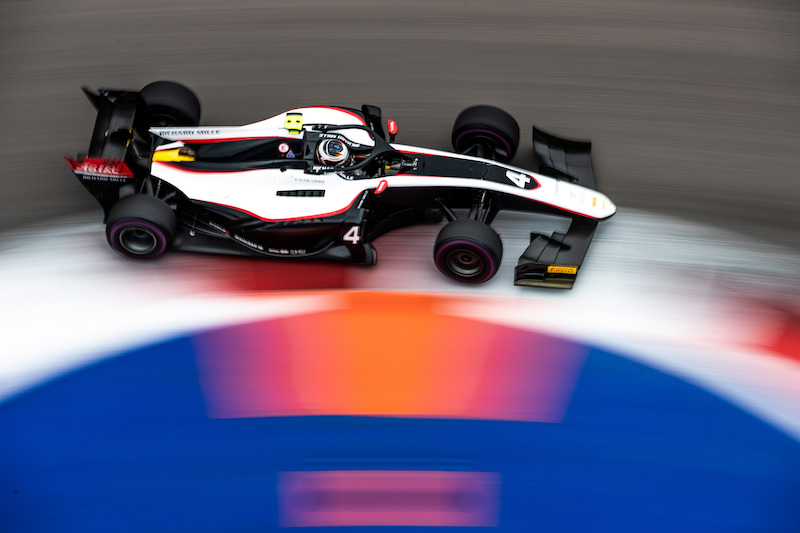Presenting our top 10 drivers of 2019 from the junior single-seater championships beneath F1
10. Nicholas Latifi
Re-entry (16th in ’17)
Took four wins and second overall in F2 before F1 graduation
Compared to the drivers that graduated from Formula 2 one year ago, an air of ambivalence met the news that Latifi will step up to Formula 1 in 2020, but it’s easy to forget how strongly he started the season.
After a 2018 season that was hampered by illness, but ended with him comparing favourably to team-mate Alex Albon nonetheless, Latifi needed to prove a point in 2019 and do enough to secure his superlicence.
Yes, this was his fourth full year in the series, all with the same team, but his three wins in the first three rounds – the feature races in Bahrain and Barcelona and the Baku sprint – was a genuinely impressive haul, and one that put him 39 points in front of Nyck de Vries.
His lack of a pole position – not just this season but across his entire F2 career – has rightly been a cause for criticism. But it does mean that all four of his 2019 wins – he added another feature race win in Hungary – had to be worked for, and showed his prowess in racing situations.
Unfortunately, he undid most of his early hard work with a shockingly scrappy weekend in Monaco, and having been spun around by his team-mate in Austria, it took until Silverstone for him to get back on the podium. By then, he wasn’t sounding overly optimistic of reeling de Vries back in, and after another double non-score at Monza (after tangling with Guanyu Zhou), he effectively resigned all hope. Comfortable, no doubt, that he was on course for his F1 drive regardless.
Few will expect Latifi to trouble his new team-mate George Russell next year, but his 2019 wins proved that – helped by the guidance of the late Jean-Paul Driot – he’s grown from a driver with potential into a well-rounded racer.
9. Guanyu Zhou
Up 25
Euro F3 graduate impressed as F2’s leading rookie
After an underwhelming Formula 3 stint where he struggled to justify his status as a Ferrari junior, Zhou looked like a different driver in 2019 as he stepped up to F2 in Renault colours and starred as the championship’s top rookie.
Helped by a strong team in Virtuosi, he was on the pace from the start as his fourth place in the Bahrain sprint race showed, and by Barcelona he led the feature race on merit and scored his first podium.
More followed in the Monaco and Paul Ricard sprint races, and his progress was confirmed when he beat veteran team-mate Luca Ghiotto in a straight fight for pole at Silverstone.
A bad start meant he finished third again in that race, and his ultimate lack of a win, and lack of obvious improvement over the rest of the season, was a little disappointing. But another podium in the Abu Dhabi feature race showed he hadn’t lost his way, either.
While he said he found the tyres to be the hardest thing to get used to, maybe born of his lost lead in Barcelona, he impressed with how well he did get to grips with them for a driver who came from European F3 rather than GP3.
That gives him a platform to build on next year, when the main target has to be the superlicence points that could turn the prospect of China’s first F1 driver into a reality.
Further reading
How Guanyu Zhou became F2?s surprise star rookie
8. Christian Lundgaard
No change
Best F3 newcomer further grew his reputation
Although Lundgaard wasn’t a factor in the FIA Formula 3 title fight, he was, unlike the main protagonists, a total newcomer at this level, with the exception of his one-off GP3 appearance in mid-2018.
Historically, Formula Renault graduates, such as Daniil Kvyat and Jack Aitken, took time to find their feet in GP3, but Lundgaard had no such problems as he beat Prema’s European F3 converts to win the opening race in Barcelona – at least for a few seconds, until he was given a penalty for a virtual safety car infringement that demoted him to second.
Such a performance was the sort of thing Esteban Ocon or Charles Leclerc could do in their early F3 days, except after an even greater leap in power.
On that form, Lundgaard would have been a serious title threat, but ART struggled surprisingly to repeat that pace with any sort of consistency. When the team was strong at the Hungaroring, Lundgaard seized his chance, taking the win from pole ahead of team-mate Max Fewtrell.
Another pole position came in the hectic qualifying session at Monza, but an early tangle with Lirim Zendeli ultimately meant he would score no further points, and he finished sixth in the standings. A further sign of his ability came in Macau though, when he finished third in the qualifying race behind Juri Vips and Robert Shwartzman, and fourth in the main event.
His move up to F2, firstly for Abu Dhabi with Trident and then for 2020 with ART, is a strong sign of Renault’s belief in Lundgaard’s talent, and one that could give it a headache if he impresses again next year.
7. Anthoine Hubert
Up 2
Rookie shone with two special wins before fatal crash
It would be all too easy to inflate Hubert’s position as a result of his tragic loss in the horrendous Spa F2 crash. But the simple truth is that he was already on course for a place in this top 10, having impressed many with his performances in his rookie season.
It would not be an exaggeration to suggest that the F2 paddock lost its single greatest prospect on that dreadful day.
That’s not necessarily a status he held in the eyes of many at the start of the year, even as the reigning GP3 champion. And his chances of a strong campaign looked slim as he and the Arden team struggled for speed through pre-season testing. But Hubert arguably made a greater impression over the races that followed than at any previous point in his career, as?F2’s complexities played to the same strengths that led to comparisons with his hero-turned-mentor at Renault, Alain Prost.
He wowed in his first race as he went from 11th to fourth without a working radio, and such storming race drives from further back on the grid would soon become the norm. There was 15th to sixth in Barcelona, and then a win in the Monaco sprint race as he kept Louis Deletraz at bay, just. He repeated the feat next time out, on home soil, again after qualifying 15th.
Together with new partner HWA, Hubert was helping to drive the Arden F2 effort forwards, and in Austria he somehow joined de Vries on the front row. The points he scored for fourth the next day would be his last.
Despite the lack of funds that led him to Arden in the first place, F2’s top teams were chasing Hubert for 2020. That in itself speaks volumes of the impact he made in his last, unfinished, season.
Further reading
How Hubert was enhancing his reputation in the F2 pack
Anthoine Hubert: 1996-2019
6. Jack Aitken
Up 36
Bounced back with three giant-killing F2 wins?
After his tough debut F2 campaign with ART in 2018, few rated Aitken’s chances of bouncing back in 2019 with Campos Racing, but that’s exactly what he did.
Following his third win of the year in the Monza sprint race, it looked like he could have the momentum to snatch second place in the standings. To simply be in that position was an achievement in itself, even though his season ended with a whimper and fifth place overall. Though of a similar age, Aitken was fighting with drivers with more experience in F2, and thus a better knowledge of everything that it takes to succeed in the series.
Aitken firmly outperformed what Ghiotto had achieved at Campos the previous season, with he and engineer Jan Sumann working together to help push the team forward. Qualifying was still a weak point (although some progress was shown by the third places in France and Belgium) but Aitken didn’t let it get him down, instead placing confidence in his ability to move forward in the races.
Baku provided the best opportunity for that, and Aitken seized it to take the feature race win, as well as a sprint race podium. Further feature race podiums came with second in Spain and third in France and Hungary. Brilliant starts, great tyre management and bold racecraft were keys to his success, and all on show in his home sprint race win at Silverstone. His winning move on Louis Deletraz as rain began to fall was the overtake of the season.
His win in the Monza sprint race – an emotional one dedicated to his Renault colleague Hubert – was somewhat different, as he defended from behind after starting from pole. It put him fourth in the standings, just 13 points behind Latifi and two behind Ghotto, so he was unlucky to end up 55 behind, especially after being taken out by an errant Nikita Mazepin from a front row start in the Sochi sprint.
Further reading
How Campos and Jack Aitken became a force in Formula 2
5. Jehan Daruvala
Up 43
Rivalled illustrious team-mates in dominant Prema F3 side
Daruvala was expected to play third-best to his highly-rated, Ferrari-supported team-mates after joining Prema for FIA F3. The final championship standings would ultimately play out that way, but he was only a point behind Marcus Armstrong, and arguably provided a much stronger threat in the title race, briefly leading it at one stage as he and Robert Shwartzman proved hard to separate.
The first round at Barcelona went just as the form guide suggested, with his reversed-grid race victory coming only after he’d trailed home in seventh in race one. But then he was only narrowly beaten (by Jake Hughes) to pole at Paul Ricard, and took a second straight win in the race.
Having beaten Shwartzman in Austria, finishing second to Juri Vips at Silverstone put Daruvala two points ahead at the top of the standings, but a needless late tangle with Pedro Piquet in race two was costly, and he lost further ground at the Hungaroring.
He took pole at Spa, but finished only third as Piquet pulled away and Shwartzman overhauled him for second. He was second to Shwartzman once more at Monza, but that was enough to mean it was he, and not Vips or Armstrong, that would take the title fight down to the final round.
Daruvala was no match for his team-mates in Sochi but would still have taken a deserved second in the standings had he not had to start the race from the pits after inadvertently triggering the throttle learning procedure on the grid.
An injury kept him out of Macau and the Abu Dhabi F2 test, but it would be a surprise if he didn’t make the step up after his strongest season yet in cars.
4. Marcus Armstrong
Up 2
Second in FIA F3 a well-earned reward after trying season?
The expectations on Armstrong heading into FIA F3 probably exceeded his experience, but after a year in which nothing ever seemed to go his way, second in the standings and a convincing performance in the final round left a positive impression.
Being pipped to the Toyota Racing Series title by compatriot Liam Lawson at his third attempt was a difficult start to Armstrong’s year, and in FIA F3 he struggled to gain the upper hand over his Prema team-mates. Being turned around by Hughes while fighting for second at Paul Ricard was the first of many missed opportunities.
At the Red Bull Ring he dominated Friday, but pole became third in the first race after the “Indy 500”-style DRS-fest he expected turned out to be anything but. He was set to overcome an almighty battle with Shwartzman on the last lap to win race two when they collided and he came off worst.
By now, Armstrong was playing catch up in the title race, and he never really had the pace again to make amends. The race two wins at the Hungaroring and Spa were well-executed recoveries from qualifying nightmares, but luck seemed to be against him again at Monza when he was penalised for a safety car infraction after finishing second in a Prema 1-2-3, ending any lasting hopes.
The most impressive thing about Armstrong’s season was not his pace, but the 19-year-old’s refusal to let his head drop in the face of so many disappointments. He never stopped fighting, as shown by his Sochi performance, where he went from third to first to fourth and back to first to defeat Shwartzman in race one, and was second in race two to snatch championship runner-up honours from Daruvala.
The Macau Grand Prix was possibly peak Armstrong, who was rapid and on top in qualifying two until he hit the barriers, and then got held up at the start of the qualifying race, thwarting any possible fightback. In the main event he worked his way through to eighth, but even then, his old nemesis Lawson came from even further back to beat him.
While it will only be his fourth full year in cars, Armstrong’s step up to F2 for 2020 is entirely logical, and with an ART car underneath him, the expectations will be high once again.
3. Juri Vips
Up 2
Red Bull junior took the fight to Prema in FIA F3
Some feared that Vips wouldn’t be able to demonstrate his talent in FIA F3 after being placed by Red Bull at Hitech GP, and – thanks to the sheer dominance of Prema that transpired – it could be argued that he was indeed held back. But the Vips-Hitech combination was the only one to make the Estonian’s old Formula 4 squad sweat.
The promise was there in Vips’ race pace in the first couple of rounds, but it wasn’t until the Red Bull Ring that he and Hitech got qualifying sorted, and he converted third on the grid into a race one victory over Max Fewtrell and Armstrong.
It could hardly have been more timely, coming at his backer’s home venue in a week where former team-mate Dan Ticktum was dropped from his position higher up in the Red Bull pecking order. Vips was being talked about as a serious contender for a 2020 F1 race seat.
He followed it with another win at Silverstone, this time from pole as Hitech produced its strongest performance of the season in its own back yard. It put him within eight points of eventual champion Shwartzman, and it felt like he had the momentum on his side.
But points were dropped in a scruffy second race, and the rest of the season proved tougher than expected. Hurt by a lack of pace and several incidents, he didn’t even make it back onto the podium until he won the last race in Sochi from reversed-grid pole.
Question marks hang over that decline and whether it was him or the car or a combination of both, but Vips provided a reminder of his talents in Macau. Well-fancied after his impressive 2018 debut, he was the strongest driver of the weekend and was unfortunate not to win, instead adding his name to the long list of favourites who’ve been slipstreamed out of victory at a safety car restart.
While the rest of the FIA F3 stars step up to F2, Vips is set to be moved to Super Formula by Red Bull after contesting the final round. It would be a huge shame if such a talent is wasted trying to perform in such a tough series, but hopefully, his strong post-season testing form is a sign he can cut it.
Further reading
Could Juri Vips be Red Bull’s next shock F1 promotion?
2. Nyck de Vries
Up 11
Mated speed and maturity to clinch deserved F2 title
A lot has happened since 2012, when de Vries first made our Top 50 in his first season of car racing. For one, Max Verstappen has graduated from karts, made it to F1 and had nearly four seasons racing for wins with Red Bull. Yes, the road to this point was a long one, but that does little to take away from de Vries’ 2019: a triumphant crowning of his tumultuous career in junior single-seater racing. In fact, it probably made it all the sweeter.
He didn’t burst out the blocks like Latifi, a single sprint race win from the first three rounds arguably a disappointment. But his win in Monaco was well-deserved for his sheer speed there over the years, and the one that followed at Paul Ricard put him into a points lead that never really even looked threatened.
His season was not perfect. Tyre management was still a weakness on occasions – his lost win at the Red Bull Ring springs to mind – and as with his predecessor George Russell, the de Vries-ART combination was not as fast at some circuits (like Silverstone) as others.
The way in which de Vries actually secured the title was the standout part of his season. After the summer break, he began the latter part of the season by taking pole at Spa, a place where he was expected to go well on the account of past form. But after the tragic events of Saturday in Belgium, he never got to capitalise on his advantage.
A few days later at Monza, de Vries was excluded from qualifying after running out of fuel in a frantic session, sending him to the back of the grid. While rival Latifi got involved in contact, de Vries charged through to third place, a result he repeated on Sunday with a good slice of luck. He sealed the title with a long-awaited return to the top step in Russia.
With a point to prove after finishing fourth in 2018 as the top three went to F1, de Vries felt more at ease at ART than at Prema, and added a calmness and maturity to his game that was often missing in the past. Contributing to that perhaps was a total separation from his soured relationship with McLaren, instead joining forces with Mercedes for simulator work and, ultimately, a Formula E drive.
Given that he only finished 10 points behind Albon a year ago, added to the improvements he’s shown in 2019, de Vries arguably deserves his chance in F1 too. But with that Mercedes FE seat underneath him, and World Endurance squads also eyeing him after some impressive LMP2 runs, he’s got the potential to become one of the top professional racers around.
Further reading
The patience behind Nyck de Vries? long road to the F2 title fight
1. Robert Shwartzman
Up 14
Ferrari junior’s progression crowned with FIA F3 title
Shwartzman’s growth as a racing driver through his career to-date has been just as impressive as his increase in physical stature.
Under the guidance of the Ferrari Driver Academy, SMP Racing and his Prema team, he’s blossomed into a driver who won this year’s most competitive junior series with a consistency that few would have believed was possible from anyone at the start of the season.
Shwartzman was not champion because of his one-lap pace. His two poles, at the first and last rounds, were as many as anybody else achieved, but in the meantime, he couldn’t even get onto the front row. But like his Prema team, Shwartzman was at his devastating best in race-trim, and was almost always moving forward.
Aside from a solitary retirement, he finished every race inside the top eight, and all but one race in the top five. An outstanding record in a series with reversed grids.
Strong progress in Sunday races was Shwartzman’s strong suit, whether he’d won on the Saturday like in Barcelona, or finished fifth, like in Austria or at Silverstone. His consistency was most impressive in the first half of the season – five podiums in eight races and never outside the top five – yet this was when his points advantage over Vips and Daruvala was at its slimmest. But instead of crumble under the pressure as the year went on, Shwartzman just pulled away as his rivals made mistakes.
After the dream crowning on home ground in Sochi, he might conceivably have won in Macau too but for minor contact as the field funnelled through Mandarin.
A year ago, nobody had quite been sure what to make of Shwartzman’s late surge to third in the European F3 standings. Nobody can be in any doubt now that he’s one of the top few prospects below F1, and it’s surely only a matter of time – if he takes his form to F2 next year – before he’s in the top class.
Click here to view the rest of the 2019 Top 50




